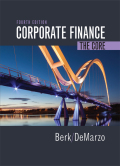
a.
Determine that after getting control of 50% shares in a leveraged buyout, the likely price of the non-tendered shares. Given that UWC, a potential prospect for leveraged buyout has 2 million shares outstanding and has a stock price of $20 and the assessment is that after buying the company and replacing the management, the value of the company will increase by 40%. For the leveraged buyout, a price of $25 will be offered.
For driving a leveraged buyout, a financial institution should be ready to fund the acquisition based on a loan. When a leveraged buyout process is started, a significant share of the company’s shares is bought at a premium from the market and pledged to the funding institution. The person or entity launching the leveraged buyout gets control of the company. The company on its
b.
Determine whether the shareholders will tender their shares, given that the share prices will be $15.50 after the announcement of the leveraged buyout. Given that UWC, a potential prospect for a 50% leveraged buyout, and has 2 million shares outstanding with a stock price of $20, the assessment is that after buying the company and replacing the management, the value of the company will increase by 40%. For the leveraged buyout, a price of $25 will be offered for 50% of the shares.
c.
Determine the gain in the transaction of the leveraged buyout firm in the transaction, assuming that all the shareholders agree to sell their shares at $25.
Want to see the full answer?
Check out a sample textbook solution
Chapter 28 Solutions
EBK CORPORATE FINANCE
- What is a blue-chip stock? a) A stock with high volatilityb) A stock of a well-established, financially sound companyc) A newly launched IPO stockd) A stock with high dividends but low growtharrow_forwardNeed help in this question !properly What does “liquidity” refer to in finance? a) The profitability of a companyb) The ease of converting assets into cashc) The stability of incomed) The level of debtarrow_forwardI need help in this question! What does “liquidity” refer to in finance? a) The profitability of a companyb) The ease of converting assets into cashc) The stability of incomed) The level of debtarrow_forward
- Dont use chatgpt and give answer What does “liquidity” refer to in finance? a) The profitability of a companyb) The ease of converting assets into cashc) The stability of incomed) The level of debtarrow_forwardThe opportunity cost of holding cash is inversely related to the level of market interest rates. Question 9 options: True Falsearrow_forwardYour firm deals strictly with four customers. The average amount that each customer pays per month along with the collection delay associated with each payment is shown below. Given this information, what is the amount of the average daily receipts? Assume that every month has 30 days. Customer Item Amount Delay A $8,500 5 days B $12,000 2 days C $16,000 3 days D $3,600 2 days Question 8 options: $8,448 $1,337 $3,342 $1,408 $10,025arrow_forward
- Which of the following is true regarding cash management? Question 7 options: The basic objective in cash management is to keep the investment in cash as low as possible while still operating efficiently and effectively. Effective cash management results in minimization of the total interest earnings involved with holding cash. A cost of holding cash is the liquidity it gives the firm. A firm should decrease its cash holdings as long as the NPV of doing so is negative. A cost of holding cash is the interest income earned on the outstanding cash balance.arrow_forwardLow default risk is a characteristic of money market securities. Question 6 options: True Falsearrow_forwardJeep Corp. held large sums of cash during the mid-1990s primarily because it would need a large amount of cash in the event of a recession. This is a[n] _____ for holding cash. Question 5 options: Adjustment motive. Compensating balances motive. Speculative motive. Transactions motive. Precautionary motive.arrow_forward
- With respect to the workings of a lockbox system, the cheque clearing process begins before the company even knows the payments have been received. Question 4 options: True Falsearrow_forwardYou are considering implementing a lockbox system for your firm. The system is expected to reduce the collection time by 1.5 days. On an average day, your firm receives 250 checks with an average value of $400 each. The daily interest rate on Treasury bills is .02%. What is the anticipated amount of the daily savings if this system is implemented? Question 3 options: $30 $25 $15 $20 $10arrow_forwardDisbursement float is virtually eliminated when payments are made electronically. Question 2 options: True Falsearrow_forward

 Intermediate Financial Management (MindTap Course...FinanceISBN:9781337395083Author:Eugene F. Brigham, Phillip R. DavesPublisher:Cengage Learning
Intermediate Financial Management (MindTap Course...FinanceISBN:9781337395083Author:Eugene F. Brigham, Phillip R. DavesPublisher:Cengage Learning


